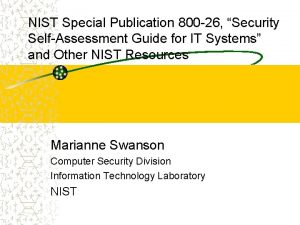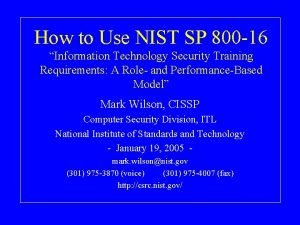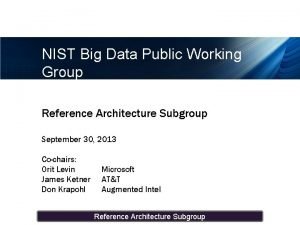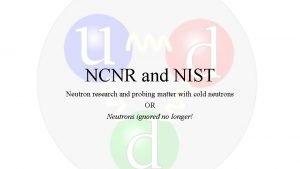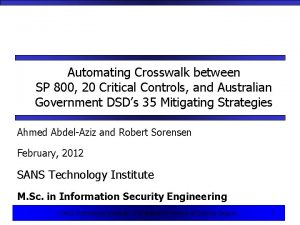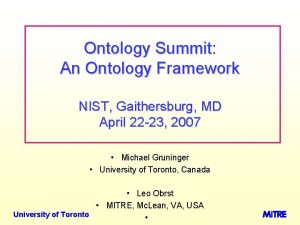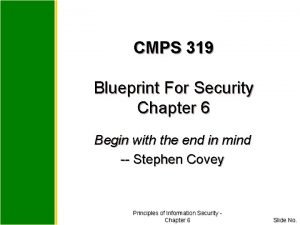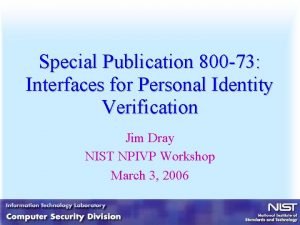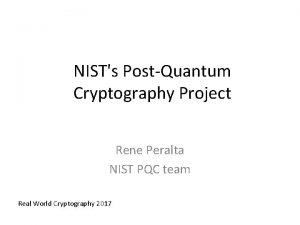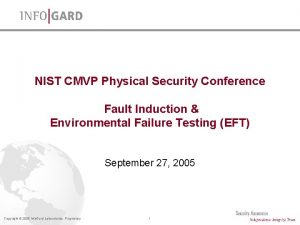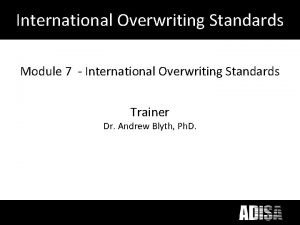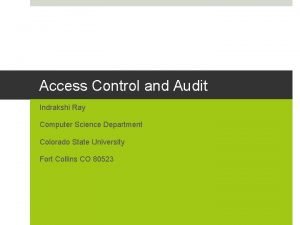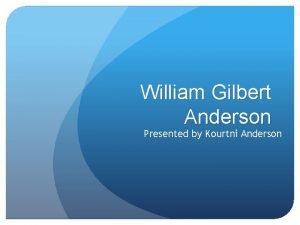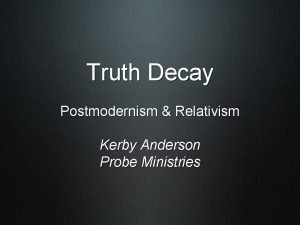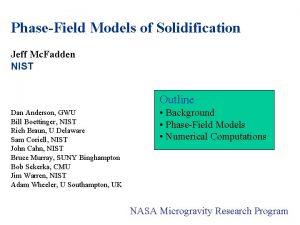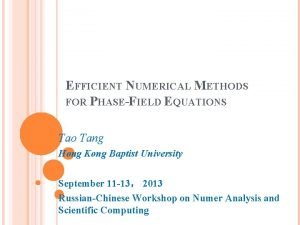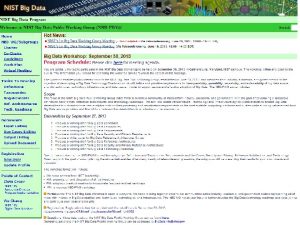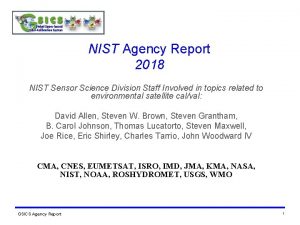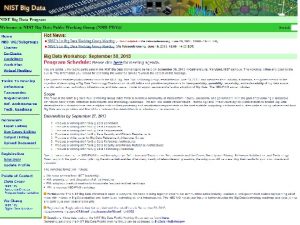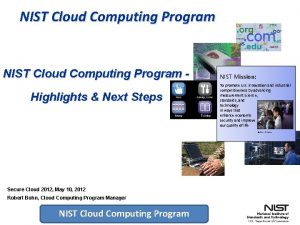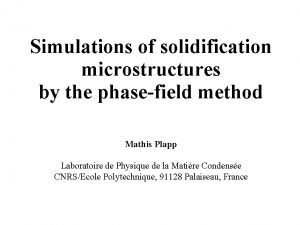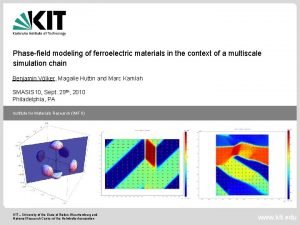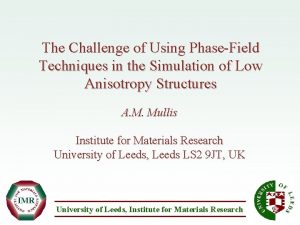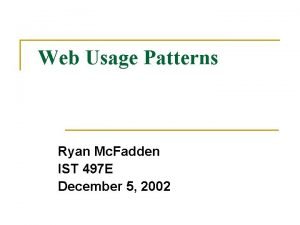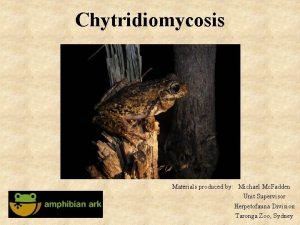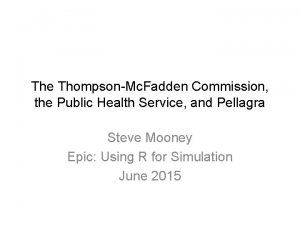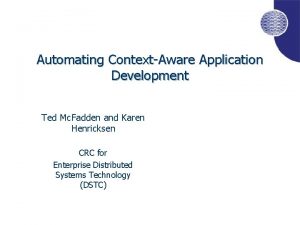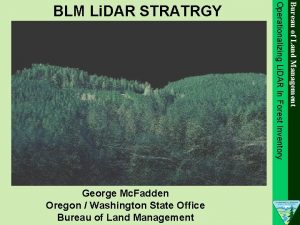PhaseField Methods Jeff Mc Fadden NIST Dan Anderson





















































- Slides: 53

Phase-Field Methods Jeff Mc. Fadden NIST Dan Anderson, GWU Bill Boettinger, NIST Rich Braun, U Delaware John Cahn, NIST Sam Coriell, NIST Bruce Murray, SUNY Binghampton Bob Sekerka, CMU Peter Voorhees, NWU Adam Wheeler, U Southampton, UK Gravitational Effects in Physico-Chemical Systems: Interfacial Effects July 9, 2001 NASA Microgravity Research Program

Outline 1. Background 2. Surface Phenomena in Diffuse-Interface Models • Surface energy and surface energy anisotropy • Surface adsorption • Solute trapping • Multi-phase wetting in order-disorder transitions 3. Recent phase-field applications • Monotectic growth • Phase-field model of electrodeposition

Phase-Field Models Main idea: Solve a single set of PDEs over the entire domain Two main issues for a phase-field model: Bulk Thermodynamics Surface Properties Phase-field model incorporates both bulk thermodynamics of multiphase systems and surface thermodynamics (e. g. , Gibbs surface excess quantities).

Phase-Field Model The phase-field model was developed around 1978 by J. Langer at CMU as a computational technique to solve Stefan problems for a pure material. The model combines ideas from: The enthalpy method The Cahn-Allen equation (Conserves energy) (Includes capillarity) • Van der Waals (1893) • Korteweg (1901) Other diffuse interface theories: • Landau-Ginzburg (1950) • Cahn-Hilliard (1958) • Halperin, Hohenberg & Ma (1977)

Cahn-Allen Equation • Anti-phase boundaries in BCC system • Motion by mean curvature: • Surface energy: • “Non-conserved” order parameter: J. Cahn and S. Allen (1977) M. Marcinkowski (1963)

Ordering in a BCC Binary Alloy

Parameter Identification • 1 -D solution: • Interface width: • Surface energy: • Curvature-dependence (expand Laplacian):

Phase-Field Model • Introduce the phasefield variable: • Introduce free-energy functional: • Dynamics J. S. Langer (1978)

Free Energy Function

Phase-Field Equations Governing equations: Thermodynamic derivation • Energy functionals: • First & second laws • Require positive entropy production Penrose & Fife (1990), Fried & Gurtin (1993), Wang et al. (1993)

Sharp Interface Asymptotics • Consider limit in which • Different distinguished limits possible. Caginalp (1988), Karma (1998), Mc. Fadden et al (2000) • Can retrieve free boundary problem with

Outline 1. Background 2. Surface Phenomena in Diffuse-Interface Models • Surface energy and surface energy anisotropy • Surface adsorption • Solute trapping • Multi-phase wetting in order-disorder transitions 3. Recent phase-field applications • Monotectic solidification • Phase-field model of electrodeposition

Anisotropic Equilibrium Shapes W. Miller & G. Chadwick (1969) Hoffman & Cahn (1972)

Cahn-Hoffman Taylor (1992) -Vector

Cahn-Hoffman Equilibrium Shape is given by: Force per unit length in interface: Cahn & Hoffmann (1974) -Vector

Diffuse Interface Formulation Kobayashi(1993), Wheeler & Mc. Fadden (1996), Taylor & Cahn (1998)

Corners & Edges In Phase-Field • changes type when • Steady case: where • Noether’s Thm: • where • interpret as a “stress tensor” Fried & Gurtin (1993), Wheeler & Mc. Fadden 97 -plot is concave.

Corners/Edges • Jump conditions give: (force balance) • where • and Bronsard & Reitich (1993), Wheeler & Mc. Fadden (1997)

Corners and Edges Eggleston, Mc. Fadden, & Voorhees (2001)

Outline 1. Background 2. Surface Phenomena in Diffuse-Interface Models • Surface energy and surface energy anisotropy • Surface adsorption • Solute trapping • Multi-phase wetting in order-disorder transitions 3. Recent phase-field applications • Monotectic solidification • Phase-field model of electrodeposition

Cahn-Hilliard Equation Cahn & Hilliard (1958)

Phase Field Equations - Alloy { where Coupled Cahn-Hilliard & Cahn-Allen Equations Wheeler, Boettinger, & Mc. Fadden (1992)

Alloy Free Energy Function One possibility Ideal Entropy L and S are liquid and solid regular solution parameters

W. George & J. Warren (2001) • 3 -D FD 500 x 500 • DPARLIB, MPI • 32 processors, 2 -D slices of data

Surface Adsorption Mc. Fadden and Wheeler (2001)

Surface Adsorption 1 -D equilibrium: where Differentiating, and using equilibrium conditions, gives Cahn (1979), Mc. Fadden and Wheeler (2001)

Surface Adsorption Ideal solution model Surface free energy Surface adsorption

Outline 1. Background 2. Surface Phenomena in Diffuse-Interface Models • Surface energy and surface energy anisotropy • Surface adsorption • Solute trapping • Multi-phase wetting in order-disorder transitions 3. Recent phase-field applications • Monotectic solidification • Phase-field model of electrodeposition

Solute Trapping Increasing V At high velocities, solute segregation becomes small (“solute trapping”) N. Ahmad, A. Wheeler, W. Boettinger, G. Mc. Fadden (1998)

Nonequilibrium Solute Trapping • Numerical results (points) reproduce Aziz trapping function • With characteristic trapping speed, VD, given by

Nonequilibrium Solute Trapping (cont. )

Outline 1. Background 2. Surface Phenomena in Diffuse-Interface Models • Surface energy and surface energy anisotropy • Surface adsorption • Solute trapping • Interface structure in order-disorder transitions 3. Recent phase-field applications • Monotectic solidification • Phase-field model of electrodeposition

FCC Binary Alloy Disordered phase Cu. Au G. Tonaglu, R. Braun, J. Cahn, G. Mc. Fadden, A. Wheeler

Ordering in an FCC Binary Alloy

Free Energy Functional

Equilibrium States in FCC

Wetting in Multiphase Systems M. Marcinkowski (1963) Kikuchi & Cahn CVM for fcc APB (Cu-Au) Phase-field model with 3 order parameters R. Braun, J. Cahn, G. Mc. Fadden, & A. Wheeler (1998)

Adsorption in FCC Binary Alloy Interphase Boundaries Antiphase Boundaries G. Tonaglu, R. Braun, J. Cahn, G. Mc. Fadden, A. Wheeler

Outline 1. Background 2. Surface Phenomena in Diffuse-Interface Models • Surface energy and surface energy anisotropy • Surface adsorption • Solute trapping • Multi-phase wetting in order-disorder transitions 3. Recent phase-field applications • Monotectic solidification • Phase-field model of electrodeposition

Monotectic Binary Alloy A liquid phase can “solidify” into both a solid and a different liquid phase. Expt: Grugel et al. Nestler, Wheeler, Ratke & Stocker 00

Incorporation of L 2 into the solid phase Expt: Grugel et al.

Nucleation in L 1 and incorporation of L 2 into solid Expt: Grugel et al.

Outline 1. Background 2. Surface Phenomena in Diffuse-Interface Models • Surface energy and surface energy anisotropy • Surface adsorption • Solute trapping • Multi-phase wetting in order-disorder transitions 3. Recent phase-field applications • Monotectic solidification • Phase-field model of electrodeposition

Superconformal Electrodeposition • Cross-section views of five trenches with different aspect ratios – filled under a variety of conditions. • Note the bumps over the filled features. D. Josell, NIST

Phase-Field Model of Electrodeposition J. Guyer, W. Boettinger, J. Warren, G. Mc. Fadden (2002)


1 -D Equilibrium Profiles

1 -D Dynamics

Conclusions • Phase-field models provide a regularized version of Stefan problems for computational purposes • Phase-field models are able to incorporate both bulk and surface thermodynamics • Can be generalised to: • include material deformation (fluid flow & elasticity) • models of complex alloys • Computations: • provides a vehicle for computing complex realistic microstructure

Experimental Observation of Dendrite Bridging Process (c) t = 30 s fs = 0. 82 (b) t = 10 s fs = 0. 70 125 mm (a) t = 0 s fs = 0. 00 Photo: W. Kurz, EPFL (d) t = 75 s fs = 0. 94 (e) t = 210 s fs = 0. 97 (f) t = 1500 s fs = 0. 98

Dendrite side arm bridging X Y • Collision of offset arms - Delayed bridging

Coalescence of two Grains Using Multi-Grain Model P; Disjoining Pressure ggb = 0. 3 gsl = 0. 1 DT = 0 K x Large misorientation P>0 grains “repel” ggb = 0. 3 gsl = 0. 1 DT = 50 K W. Boettinger (NIST) & M. Rappaz (EPFL)

-Tensor Derivation
 Jeff anderson patterns of power
Jeff anderson patterns of power Metal coping fpd
Metal coping fpd Nist trec
Nist trec Nist sp 800-12
Nist sp 800-12 Csrc.nist.gov
Csrc.nist.gov Nist sp 800-26
Nist sp 800-26 Nist privacy engineering
Nist privacy engineering Nist cloud architecture
Nist cloud architecture Information security raci
Information security raci Nist sp 800-55
Nist sp 800-55 Nist sp 800 57
Nist sp 800 57 Sp 800-16
Sp 800-16 Nist eu
Nist eu Nist computer security handbook
Nist computer security handbook Nist+
Nist+ Carl williams nist
Carl williams nist 12 principles of information security
12 principles of information security Nist privacy risk assessment
Nist privacy risk assessment Nist big data reference architecture
Nist big data reference architecture Ncnr nist
Ncnr nist Nist bia
Nist bia Nist 80082
Nist 80082 Nist 800-20
Nist 800-20 Nist pram
Nist pram Nist frame
Nist frame Nist frame
Nist frame Nistir 7966
Nistir 7966 Visa international security model
Visa international security model Nist 800-64
Nist 800-64 Fonvalmed
Fonvalmed Nist gaithersburg address
Nist gaithersburg address Nist cybersecurity framework overview
Nist cybersecurity framework overview Nist big data
Nist big data Nist frame
Nist frame Nist 800-14
Nist 800-14 Nist
Nist What is ipdrr
What is ipdrr 800-73
800-73 Coomet
Coomet Nist pqc
Nist pqc 63 entre 3
63 entre 3 Larry reed nih
Larry reed nih Masplas
Masplas Fips 140-3 pdf
Fips 140-3 pdf Disaster recovery plan template nist
Disaster recovery plan template nist Nist data encryption standard
Nist data encryption standard Nist framework for improving critical infrastructure
Nist framework for improving critical infrastructure Improving critical infrastructure cybersecurity
Improving critical infrastructure cybersecurity Nist cos'è
Nist cos'è It fw
It fw Nist purge
Nist purge Ngac nist
Ngac nist William g anderson physical education
William g anderson physical education Kerby anderson
Kerby anderson





